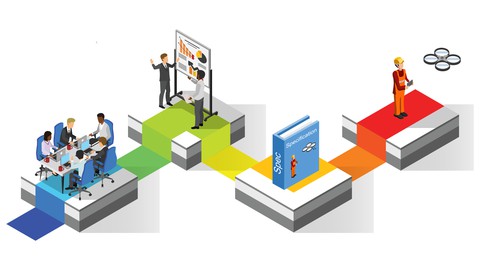
Requirements Engineering (IREB / INCOSE)
Requirements Engineering (IREB / INCOSE), available at $84.99, has an average rating of 4.5, with 85 lectures, based on 458 reviews, and has 3555 subscribers.
You will learn about Develop the skills to effectively write clear, concise, and unambiguous requirements that can be easily understood and implemented by the development team. Understand the importance of requirements engineering in the product development lifecycle. Identify and analyze stakeholder needs and requirements effectively. Learn different techniques for requirements elicitation, such as interviews, surveys, and observations. Apply effective strategies to document and manage requirements throughout the development process. Develop skills to prioritize and negotiate requirements to ensure alignment with project goals and constraints. Explore methods for validating and verifying requirements to ensure their correctness and completeness. Gain insights into the challenges and best practices associated with requirements engineering. Learn how to use tools and technologies to support requirements engineering processes. Enhance your ability to communicate and collaborate with diverse stakeholders in the requirements engineering process. Acquire practical knowledge and skills to apply requirements engineering principles in real-world product development scenarios. This course is ideal for individuals who are Systems Engineers or Project Managers or Organizational Leadership or Application / OS Software Developers or Product Development Subject Matter Experts (SMEs) or Engineering Students It is particularly useful for Systems Engineers or Project Managers or Organizational Leadership or Application / OS Software Developers or Product Development Subject Matter Experts (SMEs) or Engineering Students.
Enroll now: Requirements Engineering (IREB / INCOSE)
Summary
Title: Requirements Engineering (IREB / INCOSE)
Price: $84.99
Average Rating: 4.5
Number of Lectures: 85
Number of Published Lectures: 85
Number of Curriculum Items: 85
Number of Published Curriculum Objects: 85
Original Price: $199.99
Quality Status: approved
Status: Live
What You Will Learn
- Develop the skills to effectively write clear, concise, and unambiguous requirements that can be easily understood and implemented by the development team.
- Understand the importance of requirements engineering in the product development lifecycle.
- Identify and analyze stakeholder needs and requirements effectively.
- Learn different techniques for requirements elicitation, such as interviews, surveys, and observations.
- Apply effective strategies to document and manage requirements throughout the development process.
- Develop skills to prioritize and negotiate requirements to ensure alignment with project goals and constraints.
- Explore methods for validating and verifying requirements to ensure their correctness and completeness.
- Gain insights into the challenges and best practices associated with requirements engineering.
- Learn how to use tools and technologies to support requirements engineering processes.
- Enhance your ability to communicate and collaborate with diverse stakeholders in the requirements engineering process.
- Acquire practical knowledge and skills to apply requirements engineering principles in real-world product development scenarios.
Who Should Attend
- Systems Engineers
- Project Managers
- Organizational Leadership
- Application / OS Software Developers
- Product Development Subject Matter Experts (SMEs)
- Engineering Students
Target Audiences
- Systems Engineers
- Project Managers
- Organizational Leadership
- Application / OS Software Developers
- Product Development Subject Matter Experts (SMEs)
- Engineering Students
Welcome to the comprehensive course on Requirements Engineering! This course is designed to provide you with a thoroughunderstanding of requirements engineering processes, products, tools and techniques, and their crucial role in successful product development. Throughout this course, we will cover a wide range of topics, guiding you through each stage of the requirements engineering process and equipping you with the knowledge and skills necessary to excel in this field.
This course provides comprehensive coverage of requirements engineering principles and practices, equipping students with the knowledge and skills necessary to confidently pursue and excel in the IREB certification for requirements engineering.
We will begin with an introduction and overview, providing insights into the product lifecycle and the principles of systems engineering. Understanding these foundational concepts will enable you to contextualize requirements engineering within the broader scope of product development.
Next, we will explore the essential steps in requirements engineering, starting with the identification of product needs, goals, and objectives. You will learn effective techniques for capturing and analyzing these requirements, ensuring a comprehensive understanding of the desired product outcomes.
Scenarios, user stories, and use cases play a pivotal role in requirements engineering. We will delve into these techniques, equipping you with the skills to develop robust scenarios and user-centric requirements.
We will cover various techniques to gather requirements from stakeholders, including interviews, surveys, and observations. You will learn how to extract relevant information and ensure that all stakeholders’ perspectives are considered.
Writing requirements is a fundamental skill, and in this course, we will focus on best practices for creating clear, concise, and unambiguous requirements. Whether you are dealing with software or hardware requirements, you will learn techniques to articulate requirements effectively and ensure their alignment with project goals.
Software requirements require specific considerations, and we will dedicate a module to explore the unique aspects of software requirements engineering. You will gain insights into the challenges and strategies involved in capturing software-specific requirements effectively.
Requirements prioritization is essential for successful product development, and we will delve into techniques such as Technical Performance Measures (TPMs) to aid in prioritizing requirements based on various factors such as value, feasibility, and constraints.
The verification and validation of requirements are vital steps to ensure their correctness and suitability. We will cover techniques for verifying requirements against predefined criteria and validating them through testing and inspections.
Writing Requirements Specifications is a key deliverable in requirements engineering. We will guide you through the process of creating comprehensive and well-structured requirements specifications that serve as a reference for development and evaluation.
Conceptual diagrams, such as SysML and UML diagrams, are valuable tools for visualizing requirements. We will explore their use in representing requirements and facilitating effective communication among stakeholders.
Throughout the course, we will address common issues and challenges encountered in requirements engineering and provide strategies to overcome them. You will gain insights into requirements management, negotiation, technical reviews, and the System Requirements Review (SRR).
Lastly, we will cover the importance of requirements traceability, enabling you to establish and maintain traceability links to ensure consistency and alignment between requirements, design, and testing.
By the end of this course, you will have developed a comprehensive skill set in product development requirements engineering. You will be able to effectively elicit, document, prioritize, verify, and manage requirements throughout the product development lifecycle. Real-world examples, case studies, and hands-on exercises will reinforce your understanding and provide practical experience in applying requirements engineering principles.
Whether you are a software developer, business analyst, project manager, or involved in product development, this course is ideal for anyone seeking to excel in requirements engineering and drive the success of their product development initiatives.
Enroll now and embark on a transformative learning journey in Product Development Requirements Engineering. See you in the course!
Course Curriculum
Chapter 1: Introduction & Overview Topics
Lecture 1: Course Introduction
Lecture 2: Why Requirements?
Lecture 3: Examples Used in This Course
Lecture 4: Definitions & Terms
Lecture 5: Product Life Cycle Overview
Lecture 6: Users & Stakeholders
Lecture 7: The RFP & Development Contract
Lecture 8: System Environment & Context
Lecture 9: The System Hierarchy
Lecture 10: System Requirements
Lecture 11: Systems Engineering Overview
Lecture 12: Requirement Types (Part 1)
Lecture 13: Requirements Origination
Lecture 14: The Requirements Engineer
Chapter 2: Product Needs, Goals & Scenarios
Lecture 1: Requirements Engineering
Lecture 2: Product Needs & Goals
Lecture 3: The Mission Need Statement (MNS)
Lecture 4: Identifying Project Constraints
Chapter 3: Scenarios
Lecture 1: Introduction to Scenarios
Lecture 2: Scenarios
Lecture 3: Scenario Types
Lecture 4: Scenario Content
Lecture 5: Scenario Formatting
Lecture 6: Scenario Templates
Lecture 7: Rules of Thumb for Scenario Creation
Lecture 8: User Stories
Lecture 9: Use Cases
Chapter 4: Requirements Elicitation
Lecture 1: Introduction to Requirements Elicitation
Lecture 2: Requirements Elicitation Preparation
Lecture 3: Requirements Elicitation Techniques – Interviews
Lecture 4: Requirements Elicitation Techniques – Workshops
Lecture 5: Requirements Elicitation Techniques – Questionnaires
Lecture 6: Requirements Elicitation Techniques – Document Analysis
Lecture 7: Requirements Elicitation Techniques – Observation
Lecture 8: Requirements Elicitation Techniques – Working Groups
Lecture 9: Requirements Elicitation Tools – Brainstorming
Lecture 10: Requirements Elicitation Tools – The KJ Method
Lecture 11: Requirements Elicitation Tools – Mind Mapping
Lecture 12: Requirements Elicitation Tools – Prototyping
Chapter 5: Writing Requirements
Lecture 1: Requirements Writing – Introduction
Lecture 2: Requirements Engineering Process
Lecture 3: Requirement Statements
Lecture 4: Requirements Derivation, Decomposition & Flow Down
Lecture 5: Defining Measures of Effectiveness (MOEs)
Lecture 6: Requirement Types (Part 2)
Chapter 6: Software Requirements
Lecture 1: Software Requirements – Introduction
Lecture 2: The Software Development Process
Lecture 3: Identifying Software Requirements
Lecture 4: Analyzing Software Requirements
Lecture 5: Validating Software Requirements
Lecture 6: Software Requirements Management
Chapter 7: Requirements Prioritization
Lecture 1: Requirements Prioritization
Chapter 8: Technical Performance Measures (TPMs), Requirements Verification & Validation
Lecture 1: Technical Performance Measures (TPMs)
Lecture 2: Requirements Verification
Lecture 3: Requirements Validation
Chapter 9: Requirements Specifications
Lecture 1: Requirements Documentation & Specifications Overview
Lecture 2: The Requirements Specification
Lecture 3: Specification Standards
Lecture 4: Specification Templates
Chapter 10: Requirements Modeling & Diagrams
Lecture 1: Requirements Modeling Introduction
Lecture 2: Requirements Modeling Tools
Lecture 3: The Entity – Relationship (ER) Diagram
Lecture 4: The Class Diagram
Lecture 5: The Data Flow Diagram (DFD)
Lecture 6: The Activity Diagram (Functional Flow)
Lecture 7: The Sequence Diagram
Lecture 8: The State Machine Diagram
Lecture 9: The Block Definition & Internal Block Diagram
Lecture 10: The Requirements Diagram
Chapter 11: The Statement of Work (SOW)
Lecture 1: The Statement of Work (SOW)
Chapter 12: Common Requirements Issues
Lecture 1: Common Requirements Issues
Chapter 13: Requirements Negotiation
Lecture 1: Requirements Negotiation Overview
Lecture 2: Requirements Negotiation Strategies
Lecture 3: Requirements Communication & Documentation
Lecture 4: Documenting Changes
Lecture 5: Managing Conflicts
Lecture 6: Managing Difficult Stakeholders
Lecture 7: Requirements Negotiation Tips
Chapter 14: Requirements Management & The System Requirements Review (SRR)
Lecture 1: Requirements Management Overview
Lecture 2: Managing Requirements Artifacts
Lecture 3: Managing Requirements Processes
Lecture 4: Product Develpment Technical Reviews
Lecture 5: The System Requirements Review (SRR)
Lecture 6: Requirements Traceability
Chapter 15: Course Closeout
Lecture 1: Course Closeout
Instructors
-
Christopher Olson
Systems Engineer, Adj Professor, CSEP, PMP
Rating Distribution
- 1 stars: 3 votes
- 2 stars: 6 votes
- 3 stars: 46 votes
- 4 stars: 174 votes
- 5 stars: 229 votes
Frequently Asked Questions
How long do I have access to the course materials?
You can view and review the lecture materials indefinitely, like an on-demand channel.
Can I take my courses with me wherever I go?
Definitely! If you have an internet connection, courses on Udemy are available on any device at any time. If you don’t have an internet connection, some instructors also let their students download course lectures. That’s up to the instructor though, so make sure you get on their good side!
You may also like
- Best Public Speaking Courses to Learn in March 2025
- Best Affiliate Marketing Courses to Learn in March 2025
- Best Email Marketing Courses to Learn in March 2025
- Best Social Media Management Courses to Learn in March 2025
- Best SEO Optimization Courses to Learn in March 2025
- Best Content Creation Courses to Learn in March 2025
- Best Game Development Courses to Learn in March 2025
- Best Software Testing Courses to Learn in March 2025
- Best Big Data Courses to Learn in March 2025
- Best Internet Of Things Courses to Learn in March 2025
- Best Quantum Computing Courses to Learn in March 2025
- Best Cloud Computing Courses to Learn in March 2025
- Best 3d Modeling Courses to Learn in March 2025
- Best Mobile App Development Courses to Learn in March 2025
- Best Graphic Design Courses to Learn in March 2025
- Best Videography Courses to Learn in March 2025
- Best Photography Courses to Learn in March 2025
- Best Language Learning Courses to Learn in March 2025
- Best Product Management Courses to Learn in March 2025
- Best Investing Courses to Learn in March 2025






















